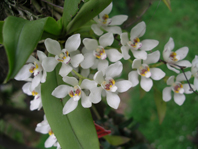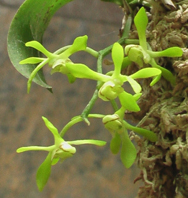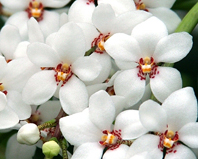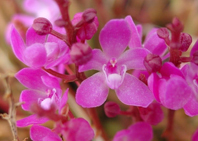About Us
Formation of the Ira Butler Trophy Committee
The Ira Butler Trophy Committee is a collaboration between the Orchid Society of NSW and Australian Native Orchid Society.
Early in 1974, a subcommittee of the Australian Native Orchid Society, consisting of Eric Gordon, John Stuart, Murray Corrigan and Phillip Spence was set up to stimulate and encourage the advancement of Australian Native Orchid Hybrids and so continue the work of Ira Butler. By the end of 1974 they set up the Ira Butler Trophy Committee. It consisted of seven elected members. A.B. Porter, W.T. Upton and Athol Bell from the Management Committee of the Orchid Society of NSW, with Eric Gordon, Phil Spence and Murray Corrigan from the Australian Native Orchid Society. The seventh member was John Stuart, an old friend of Ira Butler, the independent Chairman.
The Committee decided that trophies should be awarded to winners of the Australian Native Orchid Hybrid section of ANOS Shows and shows of State Orchid Societies. These orchids would then be eligible to be nominated for the Champion Australian Native Orchid Hybrid of the year Trophy. It took some years to organise the funding, making of the trophies and to circularise Orchid Societies. Finally in 1981 the first trophies were awarded and the Champion Australian Native Hybrid of the Year was Dendrobium Gloscester Sands, grown and owned by L. Jarvis from the ANOS Central Coast Group.
In 1985 it was decided to extend the competition for the Champion Native Orchid Hybrid of the Year to include those Orchids which had been awarded F.C.C., A.M., or H.C.C by a State Orchid Society, as some excellent orchids may not be in flower for shows. The first awarded plant to become Champion was N Grundon’s Dendrobium Hilda Poxon ‘Winfred Mary’, which was equal first with W.T. and J. Upton’s Dendrobium Elegant Heart ‘Warringah’ in 1988.
Over the years we have seen a great improvement in Native Hybrids, Dendrobium and Sarcochilus genera in particular, with an increasing number of hybridists. Many remakes of older hybrids using better parents are increasing the size and improving the colour of Native Hybrids. The Ira Butler Trophy Committee feels that they have contributed to this development and have thus continued the work done by Ira Butler.
Thanks to Ruth Rudkin and the ANOS Newcastle Group for this information.
Sarcochilus Hybrids by I.R. Butler

Sarco. falcatus

Sarco. olivaceus

Sarco. hartmannii

Rhin. divitiflora

Sarco. fitzgeraldii

Sarco. ceciliae
This article originally appeared in the Australian Orchid Review of June, 1967 and given the current and increasing popularity of the Australian Sarcs makes the re-appearance of this article a pleasant excursion into the early years of Sarcochilus hybridising.
The genus Sarcochilus in Australia consists of small vandaceous plants some of which are highly epiphytic and some of which are hardy plants growing on rocks. At least one species extends from the Atherton Tableland, inland from Cairns, to Victoria – a range of some 1,500 miles, from well within the tropics to quite temperate latitudes. They are not especially sensitive to temperature changes within reason and those not native to the Sydney area readily grow in this mild sub-tropic climate. In the language of the textbooks they are cool to intermedia orchids.
Even the smallest of them are plants of very considerable charm and they are deservedly popular. The largest would have flowers rarely exceeding 1.5″ although these could be borne in profusion. Many of them are exquisitely perfumed. Undoubtedly falcatus and hartmannii are the most popular although fitzgeraldii and the small gem ceciliae are also widely grown.
Some years ago when I first became deeply interested in orchids I looked around for an orchid family (sic.) in which work on hybridisation had not been undertaken but which had some promise of attractive results. I eventually picked on Sarcochilus. Although in the miniature class they interested me intensely and seemed to offer quite attractive prospects. I did not at the time discuss the project with other growers but I suppose that I was human enough to hope that some day others would be interested in the results. I did think that I would be able to achieve more before I would need to write about it but my interest has been so great and so many others are now working in the same field that I feel that an interim story is necessary.
The main disadvantage of the larger flowering species is that they are all white or nearly so. This suggested one target for a hybridisation programme: to produce plants similar to the larger flowered types with flowers of different colours. Some of the green and gold species – olivaceous, australis and the related Rhinerrhiza divitiflora had disadvantages with regard to culture all being highly epiphytic and one or two almost impossible to grow. This provided another objective: to produce hardy plants of easy culture. These became the two main aims of my attempts at hybridisation.
The stage has now been reached where seven hybrids have been flowered and registerd and a preliminary review of the possibilities of the genus may be made. Until a number of secondary hybrids have flowered it is quite clear that this can still only be preliminary.
Interest in breeding naturally enough centred on hartmannii on account of its general attractiveness and general ease of culture. The first lot of plants which I attempted to raise was hartmannii crossed with the golden green olivaceus, later called S. canary. It was not a particularly good cross to begin with and there were some difficulties in working out satisfactory methods of culture and many seedlings were lost. The first flowering was in 1962, sprays of beautiful canary yellow flowers, a nice colour and a big advance on olivaceus in all respects. The flowers also carried the lovely ‘ginger’ perfume of olivaceus. The best of the plants were of upward growth habit and had a tendency to throw their sprays upward. None of them have yet shown the hartmannii habit of clumping although I am still hoping that they can be multiplied in this way rather than by docking the top as with vandas. At any rate it seemed quite an interesting cross and I have since repeated it with better forms of hartmannii.
The second cross to flower was Fitzhart, between hartmannii and fitzgeraldii. Great things were not expected of this as the two species are closely related. In the event the flowers resembled fitzgeraldii much more than hartmannii, the coloured centre seeming to be a dominant feature. However, the vigour of the plants and the manner of presenting the flowers was a considerable improvement and the plants clumped very freely.
The next crosses to flower were between S. hartmannii and Rhinerrhiza divitiflora and between S. ceciliae and S. falcatus.
The first represents a new genus called Sarcorhiza and the individual cross was called S. Dorothy. These turned out to be astonishingly vigorous plants and promise to grow larger than anything else yet seen in the hybrids. They represent a considerable advance from R. divitiflora and carry its attractive golden yellow colour. Some sprays were a foot or more long and seemed to be borne quite freely. The lasting qualities of the flowers of most plants seemed quite reasonable, and much better than that of the fugacious R. divitiflora.
The other cross, S. Phyllis, seemed a most promising one to make between a very large and attractive form of falcatus, and a deep pink Atherton form of ceciliae. Flowering of the cross showed that there was no tendency for the small size of the ceciliae flower to dominate the results, many of the flowers being fully as large as some of the smaller forms of falcatus. They were a little disappointing in their colour, carrying most of this on the back of the segments, and some of the plants had short spikes with few flowers; however their flowering was on very small plants and it will be interesting to see how they perform on much larger plants.
Of the remaining crosses with have flowered little needs to be said about S. Melba and S. Minuet. Melba, a cross of hartmannii and falcatus, has only flowered on a couple of small plants and it is a bit early to judge it. The tendency seemed to be for cupped white flowers with a heavy central spotting, again emphasising the dominance of central colouration. The plants of this cross are uniform in growth and very vigorous and it may prove the earliest in the season to flower. The cross S. Minuet was made as a matter of curiosity more than anything else between hillii and hartmannii. S. hillii is a very small but perfectly formed shell pink flower with a most significant perfume. The hartmannii was also a perfumed variety and the progeny is perfurmed. The result is a gem for the real gem enthusiast rather than the grower concerned with display. Flowers have the hillii habit of coming out in succession over a long period.
The last of the seven has proved to be the most interesting. It is S. Lois, a cross between ceciliae and hartmannii. The plants, which have the upright character of ceciliae and are very hardy and vigorous, promise to be much larger than ceciliae and to have a tendency to clump. The sprays of flowers are also upright and only bend over with weight at a late stage of flowering. The flowers themselves have greater variation between plants than in any of the other crosses. Again size has not been inhibited by ceciliae and many flowers are almost as large and well shaped as the hartmannii parent. The tendency towards a central area of red spotting is again evident giving a two-tone effect to some of the flowers. Mostly they are of an attractive shade of mauve pink but grade all the way from the pink of the original ceciliae to almost white with a dark fitzgeraldii-like eye.
It has not been easy to obtain seed for secondary hybrids and this is a little frustrating. However some has been obtained and more is on the way. With more hybrids available this should be less of a problem. There is no obvious reason why some members of the Sarcochilus family should not combine with members of other vandaceous families, perhaps even with quite large ones. Some work is being done but there is nothing to report at this stage except a failure to produce any seed with Ascocentrum.
This project has been a fascinating one for me although it does take time and no short cuts are available. Much still remains to be done; there are many seedlings to flower and still many pods to sow. The above is simply reporting progress. A number of charming but small plants have been developed and these and the promise which they show of further results are, at least to me, an ample justification of my efforts.
(Sarc pictures courtesy: Neville Roper, Orchids Online and Santa Barabara Orchid Estate)
Contact
Chairman: Peter Weston
Treasurer: Graham Slater
Secretary: Irene Chalmers
Mailing Address: The Secretary, Ira Butler Committee, PO Box 5396, Chullora NSW 2190